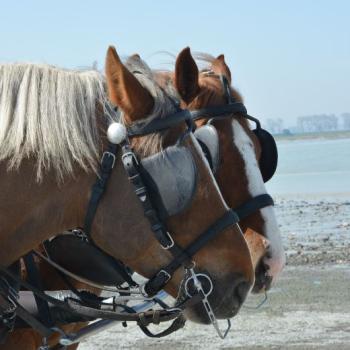Editors' Note: This article is part of the Public Square 2014 Summer Series: Conversations on Religious Trends. Read other perspectives from the Pagan community here.
Early in the morning, before the sun gets hot, I am outside shoveling compost into a wheelbarrow for my mother's badly depleted gardens. In contrast to the heavy, light brown dirt in her flowerbeds, this compost is deep, dark brown, and full of worms. Carbon is what gives it this lovely texture. I regret moving this soil, not only because it is a lot of work, but because every time I do, the stirring adds oxygen and the carbon burns off, escaping into the atmosphere. My mom will be changing her methods, and the turning of the compost heap will be changed to leaving clippings directly in the soil, where they will break down slowly and feed the plants instead of contributing to global warming.
We often hear about the use of fossil fuels as a cause of global warming, but soil is the largest pool of carbon on our planet home, even larger than trees. Tillage is the term for modern agriculture methods that require the soil to be turned over. Just as in my compost heap, when the soil is turned and oxygen is added, 20 to 50 percent of the carbon escapes. The more that escapes, the more vulnerable the soil becomes to wind erosion. Carbon, in the form of plant matter, helps hold water in soil. In the last one hundred years, Iowa has lost half of its top soil to wind and water erosion. Industrial agriculture—even organic industrial agriculture—is also associated with heavy use of fossil fuels for tillage, fertilizer, and transportation.
Permaculture, biodynamics, and holistic management are no-till methods for food production, meaning that carbon can stay in the soil where it will do the most good. These methods of food production rely on observation of the garden and landscape so that the grower can work with nature instead of in conflict with her.
Observation is the basis for relationship. That relationship may be with a human, with an animal, a plant, or the land itself. If we observe, we can see/hear/feel what is being said. Which way does the water flow on the land? Where is the garden or livestock in relation to the water? How do we conserve water? How much sun or shade is there? What kind of plants like that amount, and are there perennial natives for that spot that would feed humans, the soil, and even their fellow plants? Relationship is a response to what is really happening, the interaction between all of these pieces of information.
In contrast to my mother's garden, my own is layered with mulch. Where mulch touches the soil, it breaks down slowly. It is only disturbed to pull a weed (not many of those) or put in a new plant. Pole beans share a trellis with tomatoes where they add nitrogen to the soil for the greater glory of my Federles and Beefsteaks. Bush beans are planted next to young honeyberry bushes, and comfrey grows close by, making it easy to chop off leaves and add to the mulch. Deep-rooted comfrey and sorrel can add vital minerals to topsoil, making other plants more nutritious. Water barrels hold runoff from the roof, and the overflow feeds the bog garden.
These methods invite ponds and bogs, welcome predatory insects, and plan for wildlife. My garden hosts two tiny ponds, complete with plants and snails, and a miniature bog garden. The water gives the insects and small animals a place to drink. Damselflies rest on my squash, and lady beetles and their offspring hang out on my potatoes. In the woods below the garden, I have been tearing out invasives and re-introducing native plants: violets, bloodroot, Christmas fern, black cohosh, and trillium. Some of these are medicinal and some will attract more native insects. In the fall, I will add hostas to the lower edge of the yard: not native, but the deer love to eat them, which is much better than them eating my vegetable garden or the young trees I will also plant.
What would happen if we all grew some of our own food in this way? How much carbon could we conserve and how much more connection would we have with the land? I would characterize my relationship with my local land spirits as highly positive. They protected our house during Hurricane Sandy when no fewer than four trees came down in our back lot, all of them in the direction of our dwelling. They approve of this project and express their glee whenever I add a new plant. And clearly they approve of my lush vegetable garden, since I wouldn't have it if we still had the trees!




